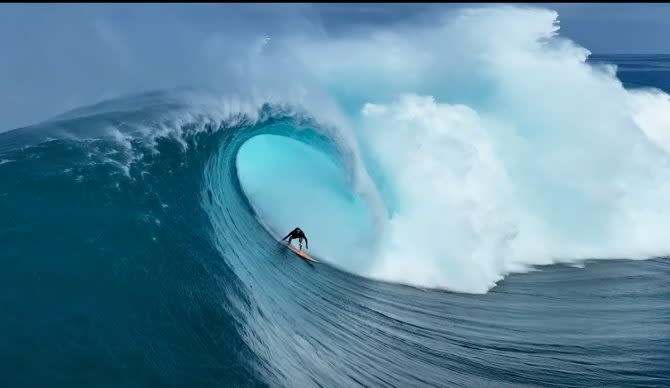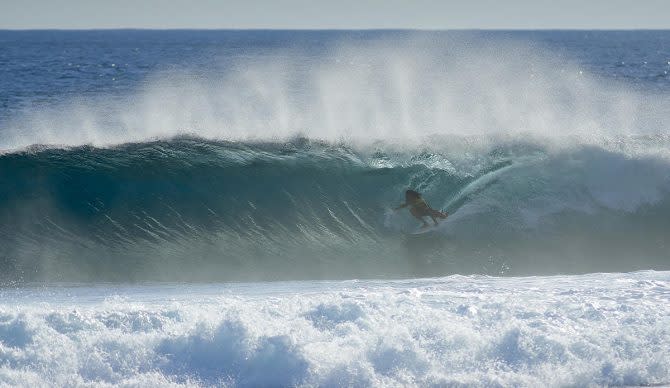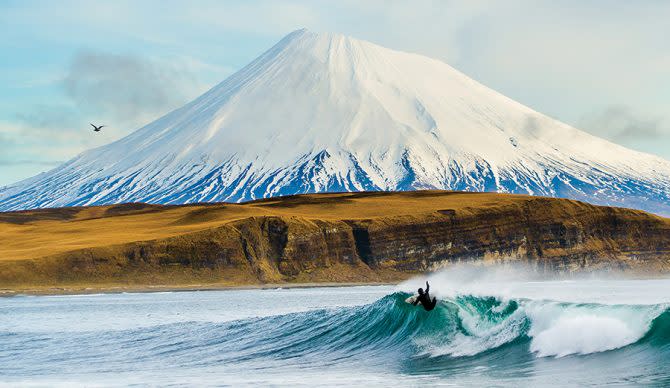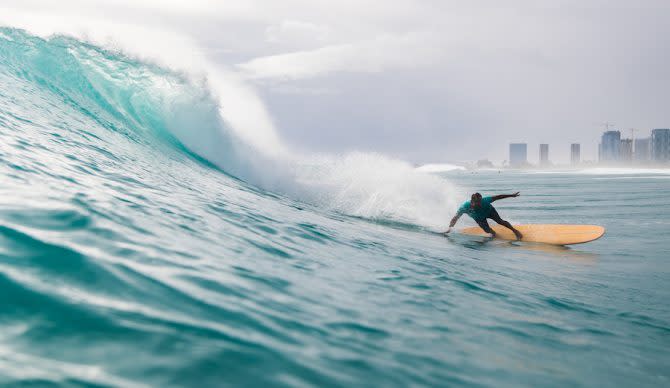The Top 10 Surf Discoveries

With the exception of a growing number of machine-generated waves, every surf spot was, at one point, “discovered.” Centuries ago, the first Angolan youngster to look out at the humble beachbreak in front of their West African fishing village and think, “Hey, it might be fun to ride those waves on a wooden tambua bellyboard,” in a sense discovered a surf spot. But the purpose of this list is to highlight examples of extraordinary waves come upon by surfers, who, whether through deliberate effort or, in some cases, sheer luck, became the first humans to ride them. And subsequently reveal them to the broader surfing world. You’ll notice that the list doesn’t include any surf spots revealed through the use of Google Earth, not because that sort of surf research isn’t, in its modern fashion, commendable, but simply to bolster my own belief that a fabulous wave being discovered from a native canoe presents a significantly more romantic tableau than pinning one on a lap-top computer. If nothing else, it makes for a much better story
10. GALVESTON BAY, TEXAS
What could make a better surf discovery story than that of a decade-long search for surf where there is no surf, until, at long last, tracking down an utterly predictable wave that offered a miles-long ride? That’s exactly what describes the remarkable effort of two Texas surf pioneers named “The Senator” and “Willy Dog,” who, beginning in the early-1990s, spent 10 years tracking down a rumor that monster oil tankers, making their way from the Gulf up the Houston Cut to inland refineries, created displacement waves that would eventually reach shoaling grounds and produce rideable waves. Prowling sketchy docks and waterfront bars, pumping suspicious commercial fisherman with booze, suffering threats of redneck violence and myriad false leads until finally a Vietnamese shrimper, speaking through an interpreter, whispered the magic words: “Channel marker 87.” Check out The Endless Summer II for what came next.

9. KUMARI POINT, ANDAMAN ISLANDS, CLOUD NINE, PHILIPPINES
These two waves share a spot on the list for the simple reason that they were both discovered by the same person: intrepid surf photographer John Seaton Callahan. Callahan’s record speaks for itself, having scoured the coastlines of literally dozens of countries looking for previously un-surfed – and un-photographed – waves. Yet these two treasure troves stand out: Kumari Point, a tropical J-Bay, because before his 1998 expedition to this remote Indian Ocean archipelago not only had no surfers ever been there before, but, in fact, very few foreign visitors of any sort, and Cloud Nine, because while by the late 1980s surfers had previously ridden a few marginal surf spots in the Philippines, no one could ever have imagined a wave the quality of the one that Callahan discovered on the tiny island of Siargao: a perfect reef break to rival any in the world.
8. NOOTKA ISLAND, BRITISH COLUMBIA
As editor of SURFER magazine (back in those days) a lot of great surf discovery stories came across my desk, but few as remarkable as the late-90s revelation that not only were there these two brothers from the tiny town of Tofino, on British Columbia’s Vancouver Island, who had taught themselves to surf by watching Momentum 10 times a day (meaning they learned to do aerial reverses before they could bottom turn) but, also suitably inspired by mags and videos, had begun exploring their remote coastal region in aluminum skiffs, looking for more challenging waves. What Canadian pioneers Raph and Sepp Bruhwiler discovered on nearby Nootka Island fulfilled their vision, which basically amounted to a cold-water Mentawai: high quality point and reef breaks, discovered around virtually every corner. Again, discovering epic waves where there were previously thought to be none – it doesn’t get any better than that.
7. MALIBU
Imagine, it’s the year 1927, and you’re a surfer in Santa Monica, California. You’ve thrilled to be riding of tumbling whitewater straight to the beach on your heavy redwood/balsa laminate, or unwieldy hollow “kookbox.” You’ve seen a few pictures of the waves of Waikiki, Corona Del Mar and San Onofre; you know that somewhere out there, surfers are riding across green, unbroken faces. Then on one summer day, you and a buddy load your big boards into the back of a wagon (legend has it drawn by a horse) and head west on the coast highway, just to see what you might see. Blithely ignoring private Rancho Malibu’s “no trespassing” signs, you proceed west until finally coming around a corner and seeing…the perfect, peeling point-break wave where modern surfing would eventually take shape. No one out, or course. Tom Blake and Sam Reid were the very first to ride it; the trajectory of surf history forever altered.
6. PE’AHI
Here’s a question: do you have to ride a wave to have discovered it? Or is this one of those “if a tree falls in a forest and nobody’s around to hear it…” sort of things? Regardless, it’s generally accepted that in 1975, three Maui surfers named John (Roberson, Lemus and Potterick respectively), working on a tip from a wise, old Hawaiian local, were the first to drive north from Pa’ia, find the rutted dirt track to the cliff, make their way down the steep, slippery rocks and paddle out at the now-legendary big wave break. Roberson recalls thinking the waves were about 10-to 12-feet (Hawaiian scale), easily handled on their 7’6” pintails. Upon reaching the lineup, however, the trio “discovered” that the waves were much larger, and much, much fiercer, then their estimate, and were all summarily driven back to shore. Remarking, upon later reflection, that the waves looked like a shark’s open mouth, they named the spot “Jaws.” And you probably know the rest.

5. ÓLAFSFJÖRǑUR, ICELAND
Although the first image of Icelandic waves first appeared in a 1968 issue of SURFER magazine, the photo taken by a U.S. airman stationed at the Keflivik Air Force Base, it wasn’t until the early 1980s that anyone began surfing the waves in nearby Sandvik and Grindivik. Two of these Arctic pioneers were Steiner (first name only, apparently) and Elli Thor Magnussen, who began circumnavigating the island’s crenelated coastline looking for an endless summer – at least in their mind’s eye. They discovered something pretty damn close way in the north, only a few miles south of the Arctic Circle: the fabulous point break at Ólafsfjörǒour, which with its clean lines and fairly regular offshore winds does a creditable 6/5/4mm impression of Cape St. Francis. It’s international debut in Taylor Steele’s 2010 film Castles in the Sky kicked off the “Great Icelandic Surf Rush.” Cue Chris Burkhart and a veritable parade of the sport’s hippest surf stars, all viewing the island’s abundance of quality surf through neoprene portholes.
4. KATIET, MENTAWAI ISLANDS
It’s a surf discovery tale often told, but still bears repeating. How, in 1991, Australian vagabond Lance Knight, having simultaneously lost a job and girlfriend, thought to sooth his soul with an Indonesian surfari. Originally planning to follow the surf mags and movies to Lagundri Bay, on the island of Nias, he changed his mind and hopped on a medical flight out of Padang, Sumatra, to the island of Sipura, in the Mentawai chain. Once there, he hired a local fisherman to take him around the west side of the island, exploring for rideable surf. When a fast-developing tempest forced them ashore in a bay called Katiet, Knight looked across the channel and beheld one of the most perfectly-shaped waves ever seen by man or surfer. After a few days of surfing it alone, Knight was understandably surprised when a salvage vessel called Indies Trader pulled up and dropped anchor, skippered by Aussie surfer/adventurer Martin Daly. Thus began the period of discovery and eventual exploitation of the world’s most productive “perfect wave” zones.
3. THABURUDHOO/KANAHURAA, MALDIVES
While discoveries like Lance Knight’s make for great surf stories, the tale of how surfing came to the chain of Indian Ocean atolls known as the Maldives is something right out of classics like the Arabian Nights. How in 1973 a modern-day Sinbad with a winger-pin named Tony Hinde, having hitched a ride on a yacht from Goa, India (helmed by an eccentric, inexperienced skipper who carried a pet monkey on his shoulder), with plans on reaching South Africa, then on to Mauritius, was shipwrecked in the northern Maldivian atolls. Eventually rescued, when en route to the capital of Malé he spotted several promising surf breaks. Rather than continuing on, Hinde made the choice to remain in Malé, build himself a native dhoni sailing craft, and eventually return to the northern atolls when the seasonal monsoon winds switched to offshore. Dropping his sail in the channel separating Thaburudhoo and Kanaraa Islands, with two epic lefts and a fantastic right all within a biscuit toss, Hinde said, “My path ends here.” He never left; in 2008, Tony Hussain Hinde died of a heart attack at the end of a ride at his beloved “Pasta Point.”
2. ULUWATU, BALI
Yes, more perfectly-formed Indonesian waves have been discovered since Uluwatu was first surfed in 1972; Padang-Padang was right next door, G-land on the next island to the north, Desert Point to the south, and let’s not even start talking about the Mentawai. But Uluwatu was the first great Indonesian surf discovery, and is still one of the best. Surf filmmaker Alby Falzon, shooting footage of surfers Rusty Miller and Stephen Cooney for his upcoming movie Morning of the Earth, visiting the spectacular cliffside temple of Uluwatu, noticing lines of swell sweeping the reef below. Trekking along the cliffs, looking for a path down to sea level, they come across a gorge, then a path, then a ravine, then a slippery bamboo ladder into a limestone grotto, then out the mouth of a cave and onto the reef…and there is one of the most spectacular surf spots on earth. All exquisitely filmed; the epic starting point of the whole Indo-surfing thing.

1.WAIKIKI, HAWAII
It’s estimated that Polynesians settled the Hawaiian Archipelago in 1000 – 1200 A.D. We know that the Marquesans and Tahitians voyagers who first came ashore on the southern island of Hawaii brought surfing with them – prone surfing on wooden paipo boards. As the islands to the north were colonized, more surf spots were found, some that even facilitated kneeling or even occasionally standing up on a short alaia. But it was tricky. So then just imagine when in the third century A.D., these proto-watermen and women first rounded the southern headland of O’ahu that they’d one day call Lēáhi (and that we call Diamond Head) and laid their eyes on the waves of Waikiki. It was in these accommodating, gently-sloping waves that the sport we know as surfing was born. Sophisticated surfboard design and wave-riding techniques, surf competition, forecasting, chants, legends and fashion; it all started here, making Waikiki, surfing’s “Fertile Crescent,” the most significant discovery in surf history.
The post The Top 10 Surf Discoveries first appeared on The Inertia.

